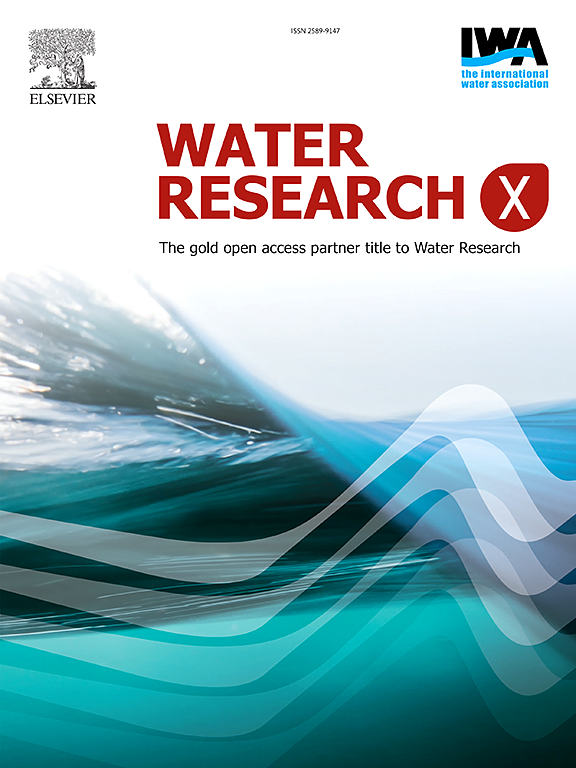从聚合氯化铝(PAC)污泥中同时进行电化学浸出、富集和回收磷作为增值钒石
IF 8.2
2区 环境科学与生态学
Q1 ENGINEERING, ENVIRONMENTAL
引用次数: 0
摘要
从废污泥中电化学回收磷(P)是缓解磷岩储量枯竭的一种可持续解决方案。然而,它的可行性和成本一直是挑战。本研究介绍了一种创新的策略,以最小的化学和能量输入,从聚合氯化铝(PAC)污泥中同时进行电化学浸出、富集和回收P (ELER)。在最佳电流密度为30 A m−2的单次5小时循环中,通过电解引起pH值的快速升高,阴极腔内的P浸出效率高达90.5%。ELER系统以214.4 kWh kg−1 P的比能耗(SEC)从模拟PAC污泥中回收了约68.8%的P。值得注意的是,电解质的选择和组成对系统性能起着至关重要的作用,Na2SO4在效率和稳定性方面都优于NaCl。增加阴极液浓度或降低阳极液浓度均显著降低磷的浸出和富集效率。此外,当优化为连续运行5个连续循环时,该系统可以实现真正PAC污泥的最终P富集效率为96.5%,同时保持相对较低的54.1 kWh kg - 1 P的SEC。富集的P结晶为高纯度的活石,这是一种增值产品,可以用作缓释P肥料或锂离子电池电极的前驱体。与其他现有技术相比,该方法的估计成本为4.3 kg - 1 P,在经济上可行。这种创新的方法有望从PAC污泥或其他富磷固体废物中有效和可持续地回收P。本文章由计算机程序翻译,如有差异,请以英文原文为准。

Simultaneous electrochemical leaching, enrichment, and recovery of phosphorus as value-added vivianite from poly-aluminum chloride (PAC) sludge
Electrochemical recovery of phosphorus (P) from waste sludge presents a sustainable solution to mitigate the depletion of P rock reserves. However, its feasibility and cost have been persistent challenges. This study introduces an innovative strategy for simultaneous electrochemical leaching, enrichment, and recovery of P (ELER) from poly-aluminum chloride (PAC) sludge with minimal chemical and energy input. A high P leaching efficiency of 90.5% was achieved within the cathode chamber through the rapid elevation of pH induced by water electrolysis at an optimal current density of 30 A m−2 during a single 5-hour cycle. The ELER system recovered approximately 68.8% P from the simulated PAC sludge at a specific energy consumption (SEC) of 214.4 kWh kg−1 P. Notably, the selection and composition of the electrolytes played a crucial role in system performances, with Na2SO4 outperforming NaCl in both efficiency and stability. Increasing catholyte concentration or reducing anolyte concentration significantly reduced P leaching and enrichment efficiency. Furthermore, when optimized for continuous operation over five successive cycles, the system can achieve an ultimate P enrichment efficiency of 96.5% for real PAC sludge, while maintaining a relative low SEC of 54.1 kWh kg−1 P. The enriched P was crystallized as high-purity vivianite, a value-added product that can be utilized as a slow-release P fertilizer or a precursor for lithium-ion battery electrodes. The estimated cost of $4.3 kg−1 P makes this approach economically viable compared to other existing technologies. This innovative approach holds promise for efficient and sustainable P recovery from PAC sludge or other P-rich waste solid.
求助全文
通过发布文献求助,成功后即可免费获取论文全文。
去求助
来源期刊

Water Research X
Environmental Science-Water Science and Technology
CiteScore
12.30
自引率
1.30%
发文量
19
期刊介绍:
Water Research X is a sister journal of Water Research, which follows a Gold Open Access model. It focuses on publishing concise, letter-style research papers, visionary perspectives and editorials, as well as mini-reviews on emerging topics. The Journal invites contributions from researchers worldwide on various aspects of the science and technology related to the human impact on the water cycle, water quality, and its global management.
 求助内容:
求助内容: 应助结果提醒方式:
应助结果提醒方式:


